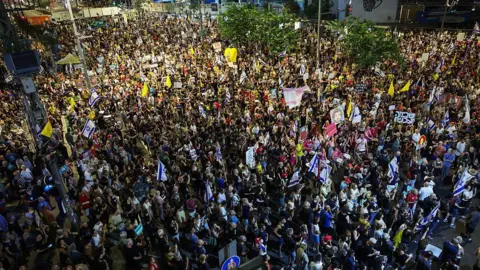Title: Enormous Protests Erupt in Israel for Hostage Release and End to Gaza Conflict
As tensions continue to escalate in the ongoing conflict between Israel and Hamas, significant crowds gathered in Israel, particularly in Tel Aviv, demanding both an end to the war and the secure release of hostages held by Hamas. Thousands of demonstrators converged in what has been termed “Hostages Square,” with organizers arguing that the government’s decision to take control of Gaza City could jeopardize the safety of approximately 20 hostages still held captive.
On what was termed a one-day national strike, disruptions were felt across various sectors, as roads, offices, and universities shut down in protest. In a notable response to these public displays of dissent, nearly 40 protesters were arrested, showcasing the government’s increasingly aggressive stance towards public demonstrations.
The Israeli Prime Minister, Benjamin Netanyahu, criticized these protests, asserting that they would only entrench Hamas’s position and delay the release of hostages. Furthermore, he suggested that public unrest could hinder negotiations, raising concerns among protest leaders about the potential repercussions of such political statements.
The protests drew fierce condemnation from some members of Netanyahu’s cabinet, including far-right Minister Bezalel Smotrich, who remarked that the demonstrations played into Hamas’s hands. Meanwhile, families of hostages spearheaded these rallies, advocating for a more balanced approach to securing hostages’ release and opposing the ongoing military expansion into Gaza.
One prominent figure among the activists, Einav Zangauker, who is the mother of hostage Matan, lamented that the Israeli government had transformed what began as a justified military response into what she characterized as a futile endeavor. Zangauker’s poignant appeal to the crowd, infused with emotion regarding her son’s plight, illustrated the struggle mothers face amidst the broader crisis.
The protests arose soon after Israel’s war cabinet voted to occupy Gaza City, a decision that has garnered international criticism, especially from the United Nations Security Council. Residents of Gaza City have begun fleeing areas like the southern Zeitoun neighborhood, where the bombardment rendered conditions “catastrophic,” according to statements from the local Hamas-run municipality.
Casualties have continued to mount amid the ongoing violence, with Gaza’s civil defense agency reporting at least 40 fatalities from Israeli attacks in recent days. Hamas condemned the Israeli military’s sustained offensives targeting various neighborhoods within Gaza City, further exacerbating the humanitarian crisis.
While protests raged in Israel, the Israeli military indicated plans to allow aid organizations to bring tents and shelter supplies into Gaza in preparation for relocating civilians from combat zones. These efforts are part of a larger strategy to manage the displacement of individuals impacted by the conflict.
Reports indicate that an overwhelming majority of Gaza’s population—approximately 1.9 million people—have already been displaced due to the hostilities, as highlighted by the United Nations. The risk of famine looms on the horizon, with the UN’s experts warning that the dire mismanagement of resources could lead to severe malnutrition across the territory, further complicating relief efforts.
The current conflict originated from Hamas’s audacious attack on Israel on October 7, claiming approximately 1,200 lives and taking more than 250 individuals hostage. Since then, the Israeli offensive has incurred staggering casualties on the Palestinian side, wherein estimates suggest that over 61,000 Palestinians have died, according to data from the Hamas-controlled Gaza health ministry.
The convergence of significant protests in Israel alongside devastating actions in Gaza highlights the complexities of the crisis, raising critical questions about the future of negotiations, humanitarian relief, and the urgent need for solutions that ensure the safety of both hostages and civilians caught in the crossfire.












